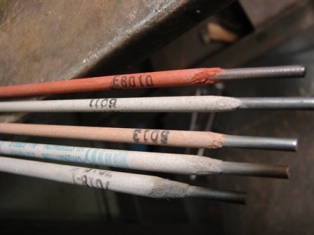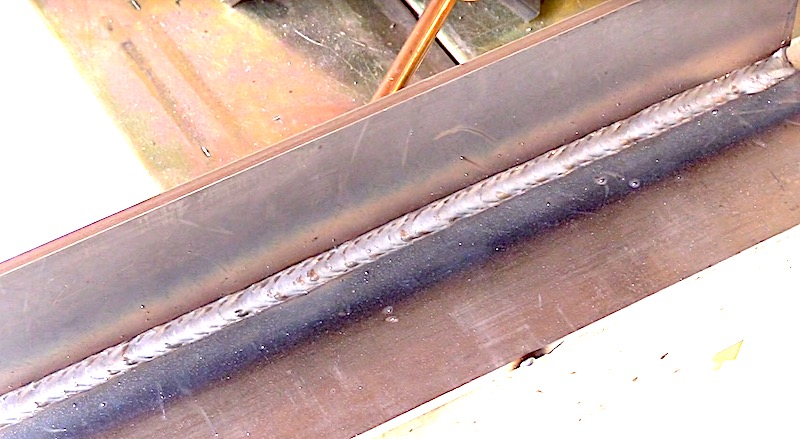Welding Steel
"you can always tell an old welder..you just cant tell him much!.. "
Welding steel is pretty fundamental to learning to weld.
Steel is basically Iron and Carbon with small amounts of other stuff like manganese. Low Carbon Steel has .3 percent carbon. Not 3 percent but 0.3 percent or point 3 percent. That’s not much. For comparison sake, Cast iron has a full 3 percent and sometimes more. That’s why cast iron is such a pain to weld and also why low carbon steel is the easiest metal to weld… low carbon steel is also the cheapest metal to buy. Low Carbon Steel is what we use to learn to weld and low Carbon steel is what we compare all other metals to when we study metals. Why? Well it’s easier to understand stuff if we can compare it to something we already know and understand. How you gonna weld anything else if you haven't learned welding steel?
Welding Steel is most often done using:
Stick welding, also called arc welding, also called SMAW,(shielded metal arc welding)
Mig welding, also called, wire welding, also called GMAW, (gas metal arc welding)
Tig welding, also called heliarc welding, also called GTAW, (gas tungsten arc welding)
Flux Core Welding ( including Dual Shield Flux Core)
I am old school. I just call them Stick, Mig, and TIG and Flux Core or Dual shield
Stick Welding steel

Stick welding uses stick electrodes with flux baked on them. Stick welding is used on the farm, and on construction sites and in the field like on a pipeline. It still rules as the most commonly used type of welding in the world. Its portable, the equipment is simple and cheap, and windy conditions don’t much matter because the flux on the rod turns into slag that protects the weld from air. In the hands of a craftsman, stick welding can produce some high quality welds. Its easy to change from carbon steel to stainless steel…all you do is change rods. I have actually had folks ask me: Does anyone really still use stick welding? Then I explain to them that the arc they see from a distance on a high rise construction job, is most likely stick welding. All you need to know about stick welding rods is 6011 and 7018. They both run on a/c or dc reverse so a 225 amp Lincoln buzz box from home depot is all you really need for a whole lot of hobby welding.
6011 penetrates deeper and can weld downhill. 7018 will look better but they suck for downhill. A 7018 bead done by a good welder looks good and is ductile and strong.
Mig Welding Steel

Mig welding is used for fabrication, manufacturing, and for body shops. It is not as portable as stick welding and unless you are using flux cored self shielded wire, windy conditions matter a lot. Several welding codes are not very MIG friendly because short circuit MIG welding in the hands of a hack, can easily cold lap making it hard to tell a good weld simply by visual inspection.
Changing from carbon steel to stainless steel is much more complicated than with stick welding because it usually involves changing shielding gas as well as the spool of wire. The good thing about mig is that it is quick and there is no slag to clean.
It lends itself well for fabrication because of this and because it allows tack welding with one hand so the other hand is free to help position the parts to be tack welded. Mig welding has a few variations like short circuit, (also called short arc) flux core, and mig spray transfer. but the kind of mig you see on American Chopper is definitely mig short circuit.
It is the most versatile mig process for welding anything from the chopper frame to the thin sheet metal gas tank.
For mig welding mild steel, use e70s6 wire and 75/25 argon/c02, if you need to weld outside get some Hobart Fabshield 21b...its one of the best self shielded flux core wires.
Tig Welding Steel
Tig welding is used extensively for pipe welding, aerospace, aviation, biomedical implants, fabrication of race cars, choppers, etc. It is much more precise and cleaner than mig welding or stick welding and definitely the coolest. Carbon steel and other metals as thin as razor blades can be welded. Outdoor windy conditions matter a lot and portable wind shields are a must if welding outside. Most tig welding is done in shops and indoors. It is one of the most versatile types of welding there is because virtually any type of metal can be welded with a few exceptions like certain alloys of aluminum that are considered unweldable (ie 7075 aluminum). Sometimes all that is needed is to pick up a different rod. Even when switching from steel to aluminum, all that is needed is a different rod and a few different settings on the tig welding machine. Just change polarity to ac, swap the high frequency to continuous and you are good to go. Make sure not to try to tig weld with rods made for gas welding. They look a lot alike but the difference is tig rods have silicon and the gas rods don’t have squat. Gas welding rods will give you porosity and just plain take the fun out of tig welding
A word on metallurgy for welding steel
Low carbon steel is not supposed to harden. In theory, there is just not enough carbon in low carbon steel to allow it to harden. Did you catch that? “ In Theory” I said. In theory you should be able to heat low carbon steel to cherry red and quench it in ice water and it should remain soft. That’s what all the long hair, propeller head phase diagrams indicate.
Why is it then that sometimes it gets hard? ( this is not the time to say “that’s what she said!”) I have tried this experiment many times and I have a theory of my own.
doctors, lawyers, butchers, bakers, and candlestick makers all make mistakes.
and so does the person in charge of quality control and carbon content of steel.
That said it is good practice to not speed cool any steel. At least not until it gets below around 500 degrees f. leave welding steel and return to home page
















